Food delivery app trends are rapidly evolving as the market grows more competitive.
To stay ahead, these apps continually adapt by embracing new innovations that resonate with modern consumers.
Trends are essential for connecting with the local audience, especially the younger generation that values convenience, technology, and personalized experiences.
As user expectations continue to grow, food delivery apps are adapting by incorporating advanced technologies like AI, with features such as voice-enabled ordering that boost customer retention.
These innovations present strong growth opportunities, positioning companies for long-term success, making them attractive to investors seeking both technological and sustainable leadership.
What is a Food Delivery App?
A food delivery app is a digital platform that enables users to conveniently order food and beverages from a wide range of local restaurants.
With just a few simple taps, meals are delivered straight to your doorstep in no time.
As the popularity of these apps continues to soar, competition in the market is intensifying, driven by the adoption of a new trend in food delivery apps.
In contrast to the traditional dining experience, where people had to visit restaurants, modern consumers now enjoy the ease of ordering from anywhere.
Create a mobile app that works with new trends like delivery tracking options and multiple payment options that have made these apps more user-friendly.
With millions of restaurant listings, food delivery apps provide a convenient way to discover new cuisines, enjoy favourite dishes, and stay updated with exclusive deals, all from the comfort of home.
Food Delivery App Market Stats
With the growing demand for food delivery apps, businesses are heavily investing in innovative technologies to enhance user experience and offer greater flexibility.
Below are the latest global statistics on food delivery app usage:
-
- The online food delivery market is projected to generate US$1.39 trillion in revenue by 2025.
- The market is expected to grow at a CAGR of 7.64% from 2025 to 2030, reaching a projected volume of US$2.02 trillion by 2030.
- Apart from that, the grocery delivery market is forecasted to see a revenue growth of 12.4% in 2026.
- By 2025, the grocery delivery segment is expected to reach a market volume of US$938.98 billion.
- In global comparison, the highest revenue will be generated by a single market with a projected US$499.14 billion in 2025.
Top Trends in Food Delivery Apps
The digital marketplace is undergoing a transformation, with rising competition in the food delivery app sector.
Driven by the emerging food delivery app development trend, these apps are capturing increased consumer attention.
Below are the top 10 trends shaping the food delivery market.
Trend #1: Integration of IoT (Internet of Things)
The integration of the Internet of Things (IoT) has revolutionized various industries, and food delivery services are no exception.
IoT enables real-time order tracking, helping both customers and businesses monitor delivery status with accuracy and transparency.
Restaurants are using smart kitchen devices to streamline cooking processes, manage inventory, and reduce food waste.
Delivery personnel can be equipped with IoT-enabled devices that optimise routes and control temperature to ensure food quality during transit.
These technologies not only improve operational efficiency but also enhance customer satisfaction by offering faster service and real-time updates.
Impact:
The use of IoT technology enhances service quality, boosts customer trust, and significantly increases operational productivity.
By enabling features such as real-time tracking, smart inventory management, and optimized delivery routes, IoT helps streamline operations while ensuring a smoother and more reliable customer experience.
It positions food delivery apps as tech-forward, dependable, and customer-centric platforms that are well-equipped to meet modern consumer expectations.
This advanced level of integration not only improves efficiency but also builds long-term brand credibility.
Trend #2: AI and ML Implementation
Artificial intelligence (AI) and machine learning (ML) are playing a pivotal role in revolutionizing the food delivery industry.
These technologies enable platforms to analyse customers' rhythm, behaviour, and preferences and help them to provide personalised recommendations and enhance the user experience.
One notable trend in food delivery apps is the use of AI-powered systems to enhance customer support by providing instant assistance and efficiently managing queries without the need for human intervention.
These AI chatbots are improving day by day by improving customer support by offering instant assistance and handling queries efficiently without human intervention.
Impact:
AI and ML significantly reduce operational costs, improve service speed, and deliver personalized experiences.
By automating support and tailoring user engagement, these technologies help boost retention and attract more potential customers.
As these food delivery app trends continue to evolve, they will enable platforms to anticipate customer needs more accurately, offering even greater levels of convenience to users.
Trend #3: AI-Powered Customer Retention
AI-powered customer retention has emerged as a vital trend in food delivery platforms, playing a key role in building lasting customer relationships.
By analyzing user data, AI can uncover behavioural patterns, preferences and other history to deliver highly personalized experiences.
This includes offering customized deals, timely notifications, and targeted promotions that match individual needs.
For businesses planning to develop a food delivery app, adding these AI-driven retention tools is essential for long-term success.
Machine learning can even predict when a customer might disengage and trigger automated re-engagement strategies, such as exclusive discounts or loyalty rewards.
Impact:
The use of AI has greatly helped to improve retention, build customer loyalty, and reduce the rates by delivering food with timely interactions.
Such food delivery app development trends understand the customer needs and deliver personalized rewards that can boost user engagement and create a more fulfilling experience.
Which leads to higher customer satisfaction and greater lifetime value with stronger market positions.
This intelligent use of AI not only strengthens customer relationships but also provides valuable insights that drive smarter business decisions and long-term growth.
Trend #4: Subscription Services
Subscription services are a popular trend in food delivery apps, offering customers convenience, savings, and a more personalized experience.
These models allow users to pay a monthly or annual fee in exchange for benefits like free delivery, exclusive discounts, and priority service.
For businesses, food delivery application trends are the main key to help businesses grow and create a stable life for people.
For businesses, subscriptions as a monetization model help build customer loyalty and create a stable, recurring revenue stream.
Impact:
The rise of subscription models in food delivery apps has significantly reshaped consumer behavior and business strategy.
Customers benefit from enhanced value and convenience, which encourages frequent use and long-term commitment to a platform.
This consistent engagement leads to more predictable demand and improved operational planning for businesses.
For companies aiming to capitalize on these benefits, it is essential to strategically develop an app that integrates a subscription-based model to drive long-term success.
Trend #5: Custom Meal Planning and Health Integration
One of the top trends currently being followed is offering custom meal planning that helps customers prioritize their wellness and nutrition through health integration features.
Food delivery apps are now offering personalized meal options based on dietary preferences, calorie counts, allergy information, and fitness objectives.
By syncing with health apps and wearable devices, users can receive tailored recommendations that align with their fitness routines and health data.
This trend not only enhances the user experience but also opens new opportunities for partnerships with fitness brands and wellness platforms.
Impact:
This significant food delivery application trend helps you transform the landscape by making it more aligned with consumers’ health and lifestyle goals.
Personalized meal planning driven by real-time health data enables users to make more informed dietary choices, leading to improved customer satisfaction and loyalty.
Moreover, this integration fosters greater engagement, as users can see tangible health benefits linked to their food consumption.
Companies can also leverage user data (with consent) to optimize offerings, develop health-focused subscription plans, and implement dynamic pricing based on dietary complexity.
Trend #6: Sustainability and Eco-Friendliness
As the industry continues to evolve, food delivery platforms are rapidly adopting new innovations.
Among the most significant on-demand food delivery app trends is the shift toward sustainable and eco-friendly practices, driven by growing consumer demand for environmental responsibility.
These initiatives include using biodegradable or recyclable packaging, cutting down on single-use plastics, and offering carbon-neutral delivery options.
Many apps are partnering with locally sourced and ethically responsible food providers.
In addition, these trends aim to minimize food waste through measures such as optimized portion sizes and systems for donating surplus food, further supporting sustainability.
Impact:
This trend appeals to environmentally conscious consumers and enhances brand reputation by showing a commitment to sustainability in food delivery apps.
By demonstrating this commitment, a new trend in food delivery apps strengthens customer loyalty, sets brands apart in a competitive market, and actively supports environmental preservation.
As sustainability becomes a priority for more users, eco-friendly practices will continue to drive engagement and support long-term growth.
Embracing sustainability also opens doors for strategic partnerships with green organizations and local eco-friendly suppliers, further expanding a brand’s impact and reach.
Trend #7: Video Reviews and User-Generated Content
Food delivery apps are increasingly incorporating video reviews and user-generated content (UGC) to create a more interactive and engaging experience.
This food delivery app trend showcases videos of their meals, unboxing and tracking real-time reactions.
Customers can now share short videos of their meals, unboxing, or real-time reactions, offering more dynamic and relatable content compared to traditional reviews.
This trend taps into the growing popularity of short-form video platforms like Twitter and Instagram Reels.
Impact:
The inclusion of video reviews and UGC enhances trust and transparency by showcasing real customer experiences.
It fosters a sense of community, encourages more authentic engagement, and can influence purchase decisions more effectively than static ratings.
By offering valuable marketing assets, food delivery app features help platforms reduce their dependence on paid advertising.
Additionally, these features enable brands to gain deeper insights into customer preferences and collect feedback, fostering a continuous cycle of innovation and enhanced user satisfaction.
Trend #8: Dynamic Pricing Model
The dynamic pricing model in food delivery apps adjusts pricing based on real-time factors such as demand, delivery time, weather, and traffic conditions.
Using AI and machine learning algorithms, the platform automatically increases or decreases the prices based on these variables to optimize the revenue system while maintaining efficiency.
This flexibility is becoming a new trend in food delivery apps, as it provides both businesses and customers with a fair, responsive pricing model that adapts to changing conditions.
Improving the customer experience while managing overall costs is the key to navigating the circumstances effectively.
Impact:
This model allows food delivery apps to charge more during the busy hours where the demand is high while allowing many offers and discounts in low-demand hours.
It has a flexible and adaptive rate model that is convenient for consumers and delivery platforms.
Nonetheless, there is a need to regulate and monitor customer expectations so that they understand the essence of the price changes in a bid to ensure that they are not dissatisfied.
These are good to know when estimating the cost to create an app that employs dynamic pricing strategies, and hence, you have to pay for the creation of sophisticated pricing algorithms.
Trend #9: Offline Mode for Browsing
Offline mode in food delivery apps allows users to browse saved menus, previous orders, and restaurant listings even without an active internet connection.
This feature is especially useful in areas with poor connectivity or during travel, enhancing app accessibility and convenience.
It empowers users to continue exploring options, planning meals, or preparing orders in advance, regardless of network limitations.
By storing essential app data locally on the user’s device, offline mode ensures that the app remains functional and user-friendly even under less-than-ideal conditions.
In competitive markets, this level of reliability can be a key differentiator for food delivery platforms aiming to expand into underserved or remote regions.
Impact:
By enabling offline browsing, food delivery apps improve user experience and reduce dependency on constant internet access.
It keeps users engaged even when they're offline, which can lead to quicker order placements once connectivity is restored.
As a result, it increases customer satisfaction and helps maintain engagement across a broader user base, especially in emerging markets or rural areas.
Additionally, having offline functionality shows a real commitment to inclusivity and accessibility; it ensures that everyone, no matter their location or internet connection, can still use the app smoothly and without frustration.
This feature reflects a growing food delivery application trend focused on making platforms more resilient, user-friendly, and adaptable to varying technological environments.
Trend #10: Augmented Reality (AR) Guidance for Easier Pickup Navigation
Implementing AR navigation in food delivery apps can be complex and resource-intensive.
It requires accurate location data, compatibility with various smartphone cameras and sensors, and integration with mapping services.
Indoor environments like restaurants or parking lots may pose challenges due to weak GPS signals.
Furthermore, maintaining AR features requires regular updates for compatibility with new devices and operating systems, adding to the complexity.
This is part of the food delivery application development trend, pushing innovation in the industry.
Impact:
To tackle these challenges, food delivery apps can utilize AR development kits like Apple’s ARKit or Google’s ARCore to create precise, platform-specific AR experiences.
By adding visual markers, QR codes, or indoor mapping systems, apps can enhance location tracking in tricky areas.
This is a new trend in food delivery apps that enhances the customer experience while addressing the complexities of navigation.
Providing a straightforward AR tutorial along with fallback navigation options ensures that even users unfamiliar with AR can quickly grasp how to use the feature.
Incorporating user feedback loops will also enable developers to continuously refine the AR experience, ensuring it stays reliable, intuitive, and aligned with real-world navigation needs.
How JPLoft Can Help You Embrace New Food Delivery App Trends?
If you’re looking to stay ahead in the competitive food delivery space, embracing new trends is key.
JPLoft, a leading food delivery app development company, can help you do just that.
We specialize in building apps that incorporate the latest features like AI-driven recommendations, dynamic pricing, and even augmented reality for easy navigation.
We know how to make these trends work for your business, ensuring your app is not just up-to-date but future-proof.
Whether you're targeting better user engagement, streamlined processes, or innovative new features, our team will help bring your ideas to life with seamless functionality.
At JPLoft, we make sure your app stays ahead of the curve while offering an exceptional user experience.
Ready to embrace the next generation of food delivery? Let’s make it happen together!
Conclusion
The food delivery industry is constantly evolving, driven by changing consumer expectations and technological advancements.
Staying ahead in these food delivery app development trends is the major challenge to remain ahead in the market to remain competitive.
By integrating features like AI-powered recommendations, dynamic pricing, and smooth user interfaces, food delivery apps can offer more tailored and efficient services, ultimately boosting customer satisfaction.
Partnering with an experienced app development team ensures that these innovations are implemented effectively.
Whether you’re building a new app or upgrading an existing one, integrating the latest trends can help you stand out in a crowded market.
The future of food delivery is all about creating smarter, more intuitive experiences for users, and the key to success lies in embracing these changes.
With the right strategies and technology in place, your food delivery app can thrive in this dynamic industry, ensuring growth and customer loyalty for years to come.
FAQs
AI can enhance food delivery apps by providing personalized recommendations based on user preferences, order history, and dietary restrictions.
Some of the newest trends in food delivery apps include AI- driven personalized recommendations that offer dynamic pricing and contactless delivery. There's also a growing emphasis on sustainability, with eco-friendly delivery options becoming more popular.
Food delivery apps optimize logistics using a blend of real-time tracking, route optimization, and fleet management systems. Advanced algorithms then calculate the most efficient routes, minimizing delays and enhancing overall delivery speed.
Dynamic pricing adjusts delivery costs based on factors like demand, weather, and local events. This boosts profitability for restaurant partners while offering customers fairer, more flexible pricing, encouraging loyalty and repeat business.
Offline functionality lets users browse menus, view past orders, and access restaurant listings without an internet connection. These trends are shaping the future of food delivery apps, making them more efficient and customer-focused.





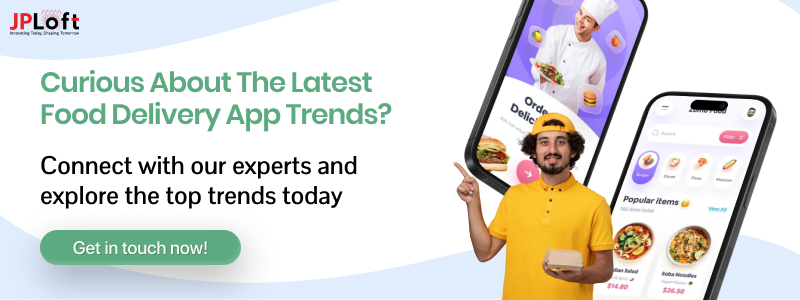
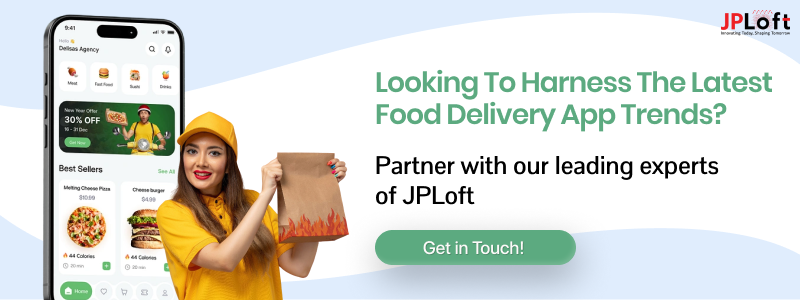

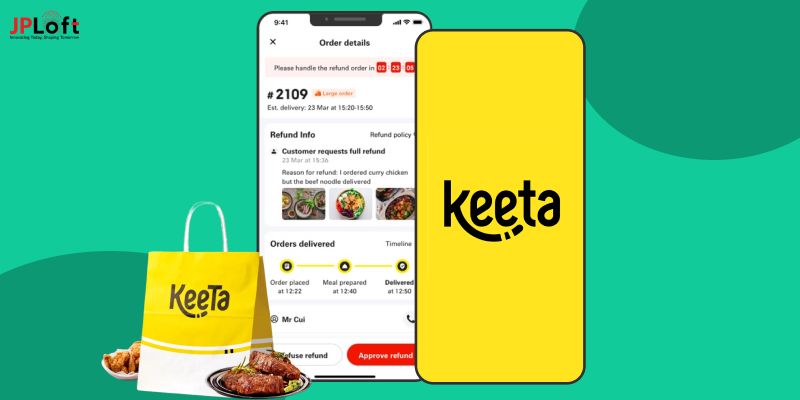
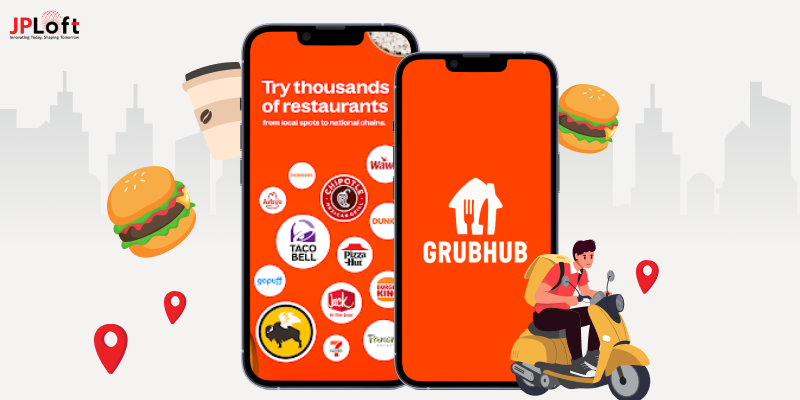
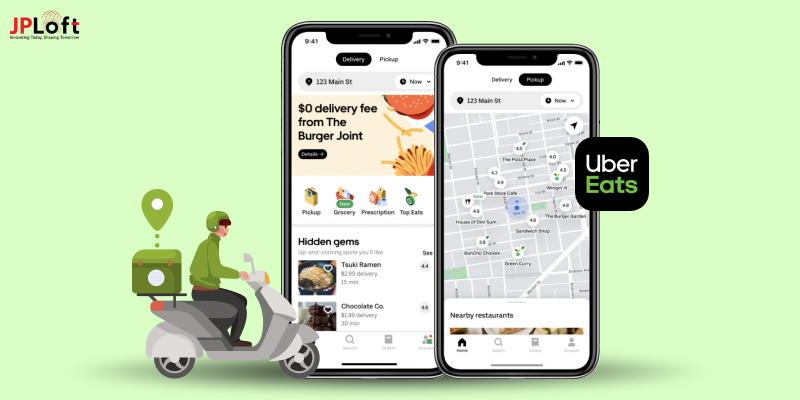


Share this blog